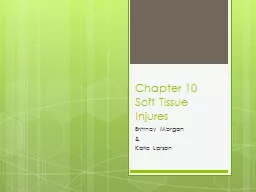

Brittney Morgan amp Katie Larson Vocabulary Soft tissues Body structures that include the layers of skin fat and muscles Wound An injury to the soft tissue Burn ID: 934697
Download Presentation The PPT/PDF document "Chapter 10 Soft Tissue Injures" is the property of its rightful owner. Permission is granted to download and print the materials on this web site for personal, non-commercial use only, and to display it on your personal computer provided you do not modify the materials and that you retain all copyright notices contained in the materials. By downloading content from our website, you accept the terms of this agreement.
Slide1
Chapter 10Soft Tissue Injures
Brittney Morgan
&
Katie Larson
Slide2Vocabulary
Soft tissues
-
Body
structures that include the layers of skin, fat, and muscles
.
Wound
-
An
injury to the soft tissue
.
Burn
-
An
injury to the skin or to other body tissues caused by heat, chemicals, electricity or radiation
.
Dressing
-
A
pad placed directly over a wound to absorb blood and other body fluids and to prevent infection.
Slide3Soft Tissues
The
soft tissues
include the layers of skin, fat, and muscle that protect the underlying body structures
.
Epidermis
– Provides a barrier to bacteria and other organisms that can cause infection.Dermis – Contains the nerves, sweat glands, oil glands, and blood vessels.Hypodermis – Contains fat, blood vessels and connective tissues.Adipose – Insulates the body to help maintain body temperature, mechanical cushion, and source of energy.
Slide4Wounds
Closed
wound
– Skin’s surface is not broken; tissue damage and any bleeding occur below the surface
Contusion – The simplest closed wound, also called a bruise. When a bump or blow occurs, it results in damage to soft tissue layers and vessels, causing internal bleeding. Blood and other fluids seep into surrounding tissues, causing discoloration and swelling.
Slide5Closed Wounds
Contusion
– The simplest closed wound, also called a bruise. When a bump or blow occurs, it results in damage to soft tissue layers and vessels, causing internal bleeding. Blood and other fluids seep into surrounding tissues, causing discoloration and swelling.
Slide6Signals of Severe Internal Bleeding:
Rapid breathing
Excessive thirst
An injured extremity that is blue or extremely pale
Slide7Open Wounds
Open wounds
- Skin’s surface is broken and blood may come through
Slide8Open Wounds
Abrasion
– Skin that has been rubbed or scraped away.
Laceration
– A cut, which may have either jagged or smooth edges.
Avulsion – A portion of the skin and sometimes other soft tissue is partially or completely torn away.
Amputation – A body part that is severed.Puncture/Penetration – when the skin is pierced with a pointed object.
Slide9General Care
Minor Wounds
Major Wounds
Embedded/Impaled Objects
Slide10Minor Wounds
Use a barrier between you and the victim
Apply direct pressure for a few minutes to control bleeding
Wash the wound thoroughly with soap and water and gently dry with clean gauze
Cover with clean dressing and a bandage
Wash hands immediately after
Slide11Major Wounds
Call 911 or emergency local number
Put on
gloves
Control external bleeding by:
Cover with dressing and press firmlyApply pressure bandage
If blood soaks through, do not remove the original bandage, add more
Slide12Major Wounds(page 2)
Monitor persons condition
Have person rest comfortably
Wash your hands
Slide13Embedded/Impaled Objects
Call 911
Put on disposable gloves
Do not remove object
Apply direct pressure to edges of the wound
Use a bulky dressing to stabilize the objectControl bleeding by bandaging the dressing in place around the object
Wash hands immediately after
Slide14Infection
Care:
Keep area clean
Soak in clean, warm water
Apply antibiotic ointment
Slide15Burns
1
st
Degree
2
nd Degree3rd Degree
Care for burnsChemicalElectrical
Slide161st Degree
Also called a
superficial burn.
Involve only the top layer of skin
Cause skin to become red and dry; are usually painful; and the area may swellUsually heal within a week
Slide172nd Degree
Also called a
partial-thickness burn.
Involve the top layers of skin
Cause skin to become red; are usually painful; have blisters that may open and weep clear fluid
Usually heal in 3 to 4 weeks
Slide183rd Degree
Also called a
full-thickness burn
.
May destroy all layers of skin and some or all of the underlying structures.
The skin may be brown or black (charred), with the tissue underneath, can either be extremely painful or painless (If the burn destroys nerve endings).
Healing requires medical assistance; scarring is likely.
Slide19Care For Burns
Heat (Thermal)
Stop the burning by removing the person from the source of the burn
Check for life-threatening conditions
Cool the burn with large amounts of cold running water
Cover loosely with a sterile dressingTake steps to minimize shock
Comfort and reassure the person
Slide20Care For Burns
Chemical
Remove the chemical from the skin, be careful not to get the chemical on
yourself
Flush the burn with large amounts of cool running water. Continue for 20 minutes.
Take steps to minimize shock
Slide21Care For Burns
Electrical
Check the scene
If possible, turn off the power at its source and care for any life threatening emergencies
Call 911
Care for shock and thermal burnsLook for entry and exit woundsCheck for additional injuries